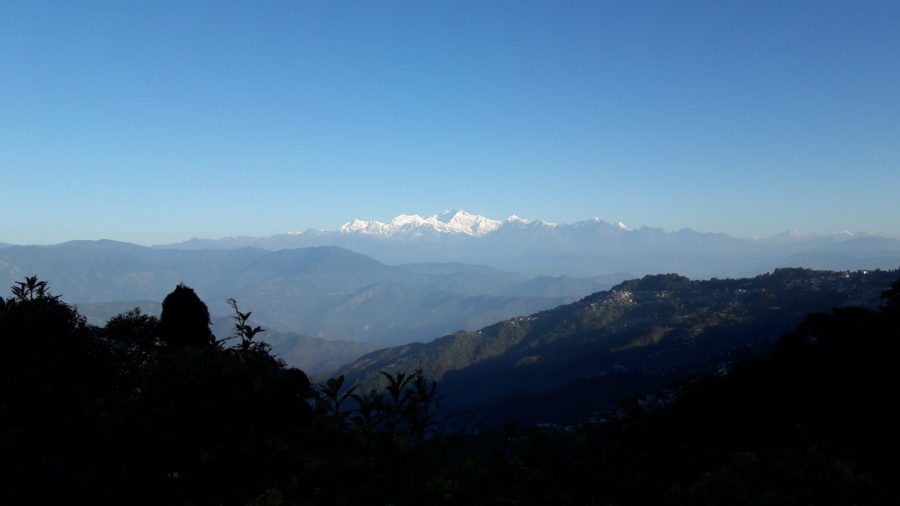We now have the ability to surround ourselves with images that we record on our mobile phones. But the best images remain in your head.
The monsoon rains have arrived in Kolkata. I was in my official car travelling through the city in the middle of a heavy storm last week. We passed an old man paddling through the rain water. He looked pleased that it was raining, and I smiled at him. He grinned back at me.
That fleeting moment would have made a great photo. I suspect any actual photograph would have been more ordinary – of an old man smiling, and maybe out of focus. But in my mind, his face is bookended with the image of a silver-grey landscape that I first looked down on from an aircraft window when I arrived almost a year ago.
I have other such moments in my head: like when we passed over the crest of a ridge in the Darjeeling hills and saw the white summit of Kanchenjunga for the first time; or the glorious light that reflected off the Hooghly as we crossed the river by boat to see the Jain temples in Murshidabad; or most recently when I saw the wide green spaces and lines of young sandalwood trees in the new city of Naya Raipur.
Some of those memories have sound too: like the soft squelching sound as I sank into the silt on the banks of the Brahmaputra; or the light rustling of the trees that provide shadow in the Assam tea gardens; or the chatter of the crowds during the Durga Puja in Kolkata.
There are many other places to visit and things to do in my part of India. I want to see the Mangrove Islands of the Sundarbans or jungle reserves and watch the Tigers, Rhinos and other wildlife. I have yet to visit the Buddhist temple of Bodhgaya where the Buddha sat under the tree of enlightenment.
As for Indian culture, I have only scratched the surface of Indian music and film. I have attended dance, fashion and other cultural programmes. The books, CDs and DVDs are piling up in our living room.
It is similar in my professional life. I have visited all the larger states in the East and North-East India. I have shaken thousands of hands and talked to many people. Yet I know that there is so much more to see, do and understand during my time in India.
This feeling is not so different from starting any other job. In your first months, everything is new and you learn a lot. Then you start to realise the limits of your understanding. With time and experience, you gain deeper knowledge and understanding.
I am about to return to Britain for the first time since I arrived in the middle of last year’s monsoon rains. What have I learnt in my first year?
The easy answer is to talk about the diversity – of people and places, of languages and cultures, of geographies and climate zones. The ethnic, linguistic and religious diversity of the roughly 50 million people who live in the North-East is as complex as Burma, which has a similar size population.
The diversity is wider than simply of people and place. There are great differences between rich and poor, and between cities and rural areas. However, the diversity is as much within, as between, areas. In Kolkata, there are all types of dwelling from sky scrapers, villas, apartment blocks, huts, shacks and the poorest living on the streets under flyovers or temporary cover.
The diversity is also of technology. I have seen rice cultivation and tea harvesting which are still largely done by hand. I have visited operation centres of British companies in Kolkata, where everyone works on computers and staff talk direct to clients in Britain and elsewhere about the services they provide. I am learning about cloud computing and the resilience of Blockchain technology.
I shall return in time for Independence Day – the 70th anniversary of India’s independence. I look forward to attending the parade that takes place on Kolkata’s Red Road, and the other events of celebration.
I will also return to focus on three main tasks.
The first is to work for the mutual prosperity of our two countries. Britain is the largest foreign investor of any G20 country in India. But building prosperity is not just about buying and selling and seeking investments in business. It is also about building capabilities and passing on technologies. I hope to work on some projects that do that.
Then there is engaging with the next generation of Indians, on which I have written recently. This is something I enjoy and which comes easily to me. Young people in India in general are respectful of their elders, and they are a little surprised that I am so ready to chat to them.
I shall also be celebrating the “living bridge” – the extensive links between India and Britain. These range beyond the business links, the shared history and the common system of democracy. It also includes the large diaspora – the one and a half million people in Britain of Indian origin.
The recent elections in Britain saw the election of 12 members of parliament (MPs) of Indian origin. To underline the point about the diversity of India, they included the first women Sikh MP, the first turban wearing Sikh, but also other Punjabis, Gujaratis and someone whose family came from Bengal.
I look forward to my return.

